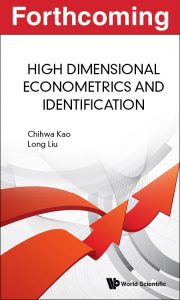 High Dimensional Econometrics and Identification, by Professor Chihwa Kao and co-author Long Liu, will be coming out in May.
High Dimensional Econometrics and Identification, by Professor Chihwa Kao and co-author Long Liu, will be coming out in May.
From the Publisher:
In many applications of econometrics and economics, a large proportion of the questions of interest are identification. An economist may be interested in uncovering the true signal when the data could be very noisy, such as time-series spurious regression and weak instruments problems, to name a few. In this book, High Dimensional Econometrics and Identification, we illustrate the true signal and, hence, identification can be recovered even with noisy data in high-dimensional data, e.g., large panels. High-dimensional data in econometrics is the rule rather than the exception. One of the tools to analyze large, high-dimensional data is the panel data model.
High Dimensional Econometrics and Identification grew out of research work on the identification and high-dimensional econometrics that we have collaborated on over the years, and it aims to provide an up-to-date presentation of the issues of identification and high-dimensional econometrics, as well as insights into the use of these results in empirical studies. This book is designed for high-level graduate courses in econometrics and statistics, as well as used as a reference for researchers.
Contents:
- Preface
- Panel Data Model with Stationary and Nonstationary Regressors and Error Terms
- Panel Time Trend Model with Stationary and Nonstationary Error Terms
- Estimation of Change Points in Stationary and Nonstationary Regressors and Error Term
- Weak Instruments in Panel Data Models
- Incidental Parameters Problem in Panel Data Models
- Bibliography
- Index
Readership: Graduate and researchers in the field of econometrics and economics.
https://www.worldscientific.com/worldscibooks/10.1142/11273
 The Social Science Research Network (SSRN), a platform for dissemination of early-stage research, recently announced their all-time top ten downloaded papers in the topic Data Visualization. Oskar Harmon’s paper “Learning Tableau: A Data Visualization Tool” with Steven Batt, and Paul Tomolonis was among that list.
The Social Science Research Network (SSRN), a platform for dissemination of early-stage research, recently announced their all-time top ten downloaded papers in the topic Data Visualization. Oskar Harmon’s paper “Learning Tableau: A Data Visualization Tool” with Steven Batt, and Paul Tomolonis was among that list. The Human Capital and Economic Opportunity
The Human Capital and Economic Opportunity Professor Thomas Miceli has published The Paradox of Punishment: Reflections on the Economics of Criminal Justice.
Professor Thomas Miceli has published The Paradox of Punishment: Reflections on the Economics of Criminal Justice. Oskar Harmon and Paul Tomolonis (UConn PhD 2017) co-authored the article “The effects of using Facebook as a discussion forum in an online Principles of Economics course: Results of a randomized controlled trial”
Oskar Harmon and Paul Tomolonis (UConn PhD 2017) co-authored the article “The effects of using Facebook as a discussion forum in an online Principles of Economics course: Results of a randomized controlled trial” High Dimensional Econometrics and Identification
High Dimensional Econometrics and Identification